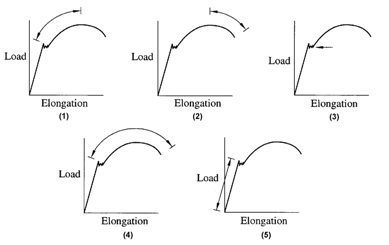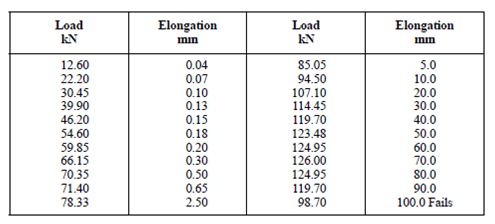Question 1
A metal rod has a diameter of 8.74 mm and supports a load of 24.6 kN. Calculate the value of true stress on the rod. The diameter was measured with the load already applied. Information for questions 2 to 5:

Question 2
In relation to the arrowed regions in which of the load-elongation curves above is the region in which work (strain) hardening occurs, most accurately depicted? Answer (1), (2), (3), (4), (5) or 'None of them'.
Question 3
In relation to the arrowed regions in which of the load-elongation curves is the region in which plastic instability or necking occurs, most accurately depicted? Answer (1), (2), (3), (4), (5) or 'None of them'.
Question 4
In relation to the arrowed regions in which of the load-elongation curves is the region where yielding occurs most accurately depicted? Answer (1), (2), (3), (4), (5) or 'None of them'.
Question 5
In relation to the arrowed regions in which of the load-elongation curves is the region where plastic deformation occurs most accurately depicted? Answer (1), (2), (3), (4), (5) or 'None of them'.
Information for questions 6 to 11:

A tensile test on a specimen having an initial diameter of 13.11 mm and an initial gauge length of 200.0 mm, gave the following data:
Plot the data in suitable graphical form and determine the values in questions 6 to 11. It is suggested to plot a separate graph to have an exaggerated 'Elongation' axis, so that the first part of the deformation process can be enlarged and accurate values can be obtained.
Also it may not be possible to calculate all of the values requested. If you think a value cannot be calculated, you should answer, 'Not possible to calculate this value'.
Question 6
What is the modulus of elasticity of the material?
Question 7
What is the limit of proportionality for the material?
Question 8
What is the proof strength of the material?
Question 9
What is the percentage reduction of area of the material?
Question 10
What is the tensile strength of the material?
Question 11
What is the true stress at maximum load for the material?
Information for questions 12 and 13:
A tensile test of a metal specimen, with an initial diameter of 9.90 mm and an initial gauge length of 65.0 mm, gave the following data in the initial stages of the test.
Question 12
What is the percentage elongation of the metal?
Question 13
What is the true stress at fracture for the metal?